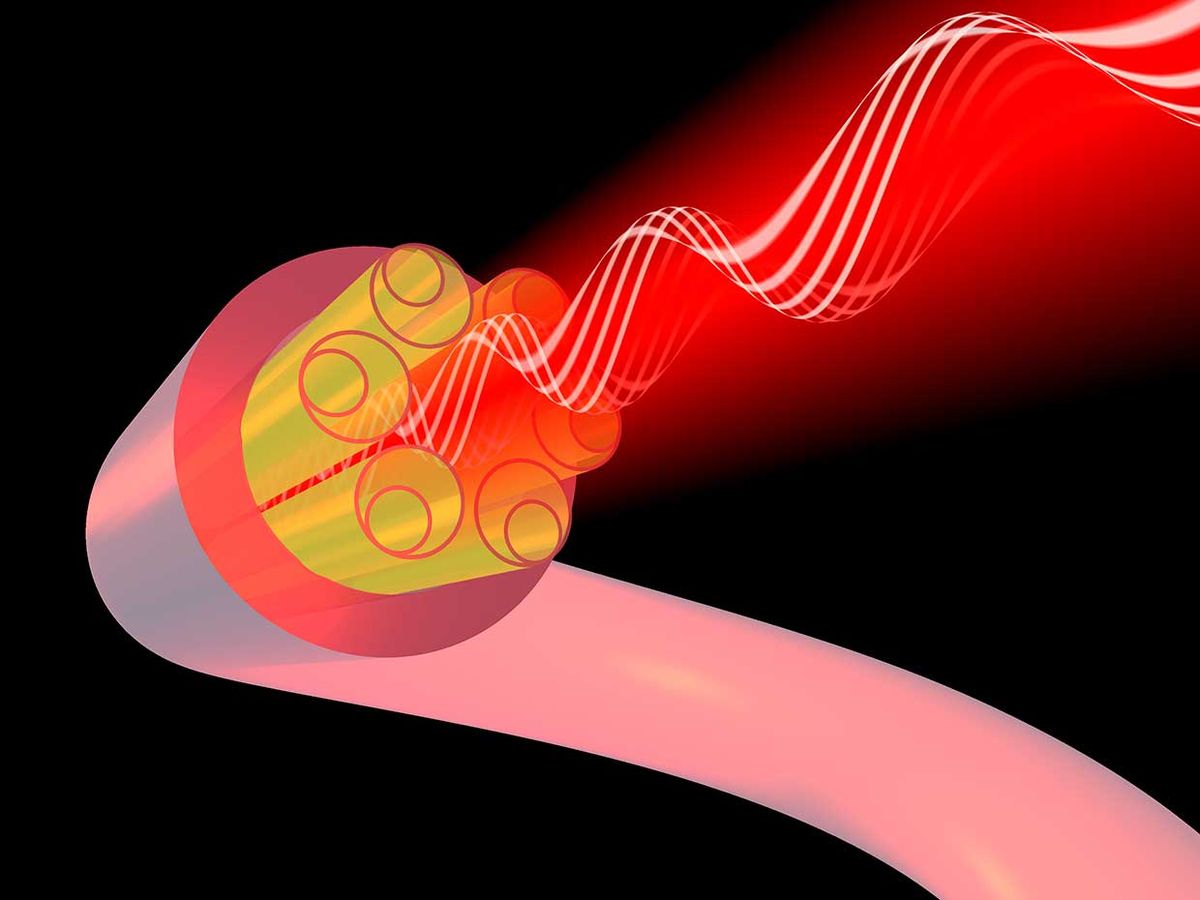Conventional fiber optics guide light through solid glass cores that are extremely transparent. The clearest fibers have loss as low as 0.142 decibel per kilometer. Which means that more than one percent of input light remains after a hundred kilometers. Yet solid glass fibers cannot carry very high powers, particularly in short pulses, limiting their use for applications including delivering intense light for laser machining.
Now a team at the University of Southampton's Optoelectronics Research Center has made hollow-core fibers that are clearer than solid-core fibers at some important wavelengths. They report their results in Nature Communications.
Interest in hollow-core fibers initially took off in 1998 after Philip St. John Russell, then at the University of Bath in the UK, showed that microstructured optical fibers could guide light within a hollow core by blocking transmission through layers around the core at some wavelengths. However, the air-filled microstructures in the fiber were very complex, while these “photonic bandgap” fibers enabled transmission of too limited a range of wavelengths to be practical.
In recent years, Francesco Poletti at Southampton has pioneered a new range of experimental fibers that depart from Russell’s basic idea by limiting the microstructure only to the hollow core of the fiber. Poletti’s 2014 design spaced several pairs of nested tubes, like small straws placed inside larger ones, around the outside of the central core.

“Lumenisity Ltd., a startup from our group, has already installed [fibers with the new design] in optical cables running live traffic,” Poletti said in an email. Light travels 50% faster in air than in glass, so the initial market for hollow-core fibers is short data links requiring extreme speed. He cites financial transfers, 5G and links inside and between data centers. It’s a potential boon for high-frequency security traders. However, it has yet to match the transmission of solid-core fibers in the telecommunications band at 1550.
Now Poletti's group has developed new hollow-core fibers that match or even beat the transparency of solid-core fibers in key wavelengths outside the telecommunications band, where glass is most transparent. They tailored fibers for 660 and 850 nm photons (these bands in the red and near infrared are widely used in biology and quantum networks) as well as for 1064 nm (another near infrared band that’s popular for industrial laser machining).
He says the new technology could offer advantages over conventional solid-core fiber for high precision sensors, laser beam delivery and time-frequency measurement. A handful of vendors already sell older types of hollow-core fibers to deliver ultrashort laser pulses that deliver a rapid series of pulses to cut glass for smartphones. “There is no alternative to hollow-core fibers because solid-core fibers cannot compete,” Poletti says. The intense light pulses have to be kept out of the glass to avoid damaging it.
So far, glass cutting is a small share of the overall market. But he says his group’s new hollow-core fibers can transport “kilowatt scale continuous powers in a fundamental mode over tens or hundreds of meters, and could soon challenge solid-core delivery fibers in the much bigger market of [industrial machining with] high average power lasers.” Analysts put sales well into the billions.
The new hollow-core fibers also have other advantages besides damage resistance and faster light speed. Keeping light out of the glass avoids nonlinear effects that can distort signals and can improve quality of the transmitted laser beam.
Fundamental limits of the new fibers are unknown. Light scattering dominates the loss of solid-core fibers at wavelengths shorter than the telecommunications band. “Up to a few months ago, we thought that scattering of light at the air-glass interfaces [in hollow-core fibers] would eventually dominate loss at those shorter wavelengths,” Poletti says. But the loss keeps dropping as they improve fiber fabrication, and he now speculates that in a few years the new hollow fibers might be ten times clearer in that band than the fundamental limit solid-core fibers.
Jeff Hecht writes about lasers, optics, fiber optics, electronics, and communications. Trained in engineering and a life senior member of IEEE, he enjoys figuring out how laser, optical, and electronic systems work and explaining their applications and challenges. At the moment, he’s exploring the challenges of integrating lidars, cameras, and other sensing systems with artificial intelligence in self-driving cars. He has chronicled the histories of laser weapons and fiber-optic communications and written tutorial books on lasers and fiber optics.



